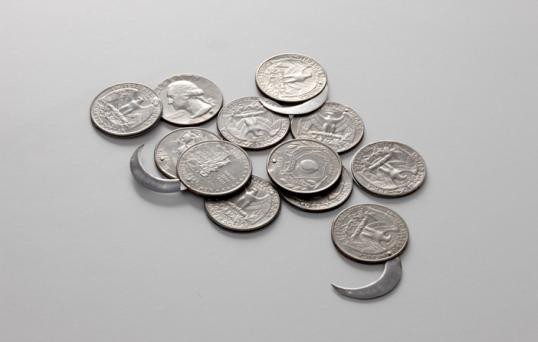Claire Fontaine
02 Jun - 22 Aug 2010
CLAIRE FONTAINE
Economies
2 June - 22 August 2010
The Museum of Contemporary Art, North Miami will present the first comprehensive U.S. museum exhibition for the Paris-based collective artist Claire Fontaine from June 3 – August 22, 2010. Featuring sculpture, painting, neon, video and text, Claire Fontaine: Economies presents works from 2006 to the present including numerous new pieces created especially for the exhibition as well as a “moving image toolbox” consisting of films and videos that have influenced Fontaine’s work. Claire Fontaine: Economies is organized by the Museum of Contemporary Art, North Miami and is curated by MOCA Associate Curator Ruba Katrib.
In 2004, Claire Fontaine took the name of a French paper company and called herself a ready-made artist. Managed by “assistants,” Fontaine’s practice is deeply imbedded in collaborative modes of working and questioning possibilities for social change.
“Claire Fontaine’s work asks us to reconsider our assumptions as art viewers as well as members of society and to question daily facets of life that are often taken for granted,” said MOCA Associate Curator Ruba Katrib. “Economies is a visual meditation on alternative value systems and on the contradictions connected to concepts of ‘ownership’ today, which is especially relevant in the current economic climate.”
Among the works on view is Untitled (Tennis Ball Sculpture) (2009), a floor installation comprised of tennis balls that are slit open to reveal their contents, including such items as hairpins, toffees, socks and batteries that become “currency” inside prisons. The work is a response to stories of contraband entering American prisons via tennis balls thrown into prison yards. In Change, (2006), Fontaine turns money into a weapon, outfitting 12 quarters with retractable box cutter blades. Untitled (Missing) (2010), is a non-functional piece of a sawed-off shotgun that despite an inability to render harm, creates a sense of unease as the whereabouts of its other parts are unknown. In Queens (2004), an animation shows a British one pound coin cheating luck as it slowly rotates to reveal that is the same on both sides, while in Recession Sculpture (American Gas) (2009), Fontaine creates a system to reduce the evidence of energy consumption with a vacuum cleaner hooked up to a propane gas meter that sucks air out of the meter, causing its numbers to go backwards.
A “moving-image toolbox” featuring films that have influenced Claire Fontaine includes: Trinh T. Minh-ha’s Reassemblage (1982), Barbette Scroeder’s Koko: A Talking Gorilla, (1978), East of Paradise, dir. Lech Kowalski, 2005; and D'amore si vive, dir. Silvano Agosti, 1984.
Funding for the exhibition is provided by the French American Cultural Exchange. A full color catalogue featuring essays by MOCA Associate Curator Ruba Katrib and Tom McDonough, Associate Professor of Modern Architecture and Urbanism at the Art History Dept. at Binghamton University will accompany the exhibition.
Economies
2 June - 22 August 2010
The Museum of Contemporary Art, North Miami will present the first comprehensive U.S. museum exhibition for the Paris-based collective artist Claire Fontaine from June 3 – August 22, 2010. Featuring sculpture, painting, neon, video and text, Claire Fontaine: Economies presents works from 2006 to the present including numerous new pieces created especially for the exhibition as well as a “moving image toolbox” consisting of films and videos that have influenced Fontaine’s work. Claire Fontaine: Economies is organized by the Museum of Contemporary Art, North Miami and is curated by MOCA Associate Curator Ruba Katrib.
In 2004, Claire Fontaine took the name of a French paper company and called herself a ready-made artist. Managed by “assistants,” Fontaine’s practice is deeply imbedded in collaborative modes of working and questioning possibilities for social change.
“Claire Fontaine’s work asks us to reconsider our assumptions as art viewers as well as members of society and to question daily facets of life that are often taken for granted,” said MOCA Associate Curator Ruba Katrib. “Economies is a visual meditation on alternative value systems and on the contradictions connected to concepts of ‘ownership’ today, which is especially relevant in the current economic climate.”
Among the works on view is Untitled (Tennis Ball Sculpture) (2009), a floor installation comprised of tennis balls that are slit open to reveal their contents, including such items as hairpins, toffees, socks and batteries that become “currency” inside prisons. The work is a response to stories of contraband entering American prisons via tennis balls thrown into prison yards. In Change, (2006), Fontaine turns money into a weapon, outfitting 12 quarters with retractable box cutter blades. Untitled (Missing) (2010), is a non-functional piece of a sawed-off shotgun that despite an inability to render harm, creates a sense of unease as the whereabouts of its other parts are unknown. In Queens (2004), an animation shows a British one pound coin cheating luck as it slowly rotates to reveal that is the same on both sides, while in Recession Sculpture (American Gas) (2009), Fontaine creates a system to reduce the evidence of energy consumption with a vacuum cleaner hooked up to a propane gas meter that sucks air out of the meter, causing its numbers to go backwards.
A “moving-image toolbox” featuring films that have influenced Claire Fontaine includes: Trinh T. Minh-ha’s Reassemblage (1982), Barbette Scroeder’s Koko: A Talking Gorilla, (1978), East of Paradise, dir. Lech Kowalski, 2005; and D'amore si vive, dir. Silvano Agosti, 1984.
Funding for the exhibition is provided by the French American Cultural Exchange. A full color catalogue featuring essays by MOCA Associate Curator Ruba Katrib and Tom McDonough, Associate Professor of Modern Architecture and Urbanism at the Art History Dept. at Binghamton University will accompany the exhibition.

